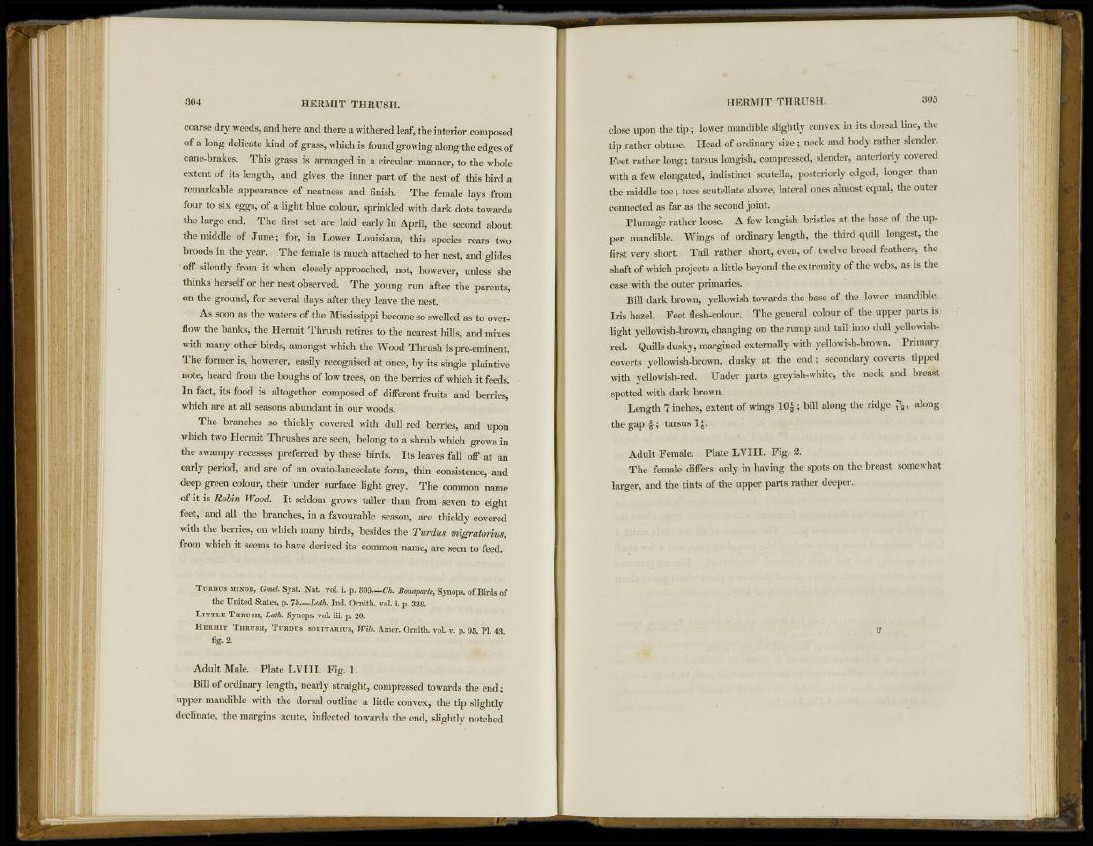
304 HERMIT THRUSH.
coarse dry weeds, and here and there a withered leaf, the interior composed
of a long delicate kind of grass, which is found growing along the edges of
cane-brakes. This grass is arranged in a circular manner, to the whole
extent of its length, and gives the inner part of the nest of this bird a
remarkable appearance of neatness and finish. The female lays from
four to six eggs, of a light blue colour, sprinkled with dark dots towards
the large end. The first set are laid early in April, the second about
the middle of June; for, in Lower Louisiana, this species rears two
broods in the year. The female is much attached to her nest, and glides
off silently from it when closely approached, not, however, unless she
thinks herself or her nest observed. The young run after the parents,
on the ground, for several days after they leave the nest.
As soon as the waters of the Mississippi become so swelled as to overflow
the banks, the Hermit Thrush retires to the nearest hills, and mixes
with many other birds, amongst which the Wood Thrush is pre-eminent.
The former is, however, easily recognised at once, by its single plaintive
note, heard from the boughs of low trees, on the berries of which it feeds.
In fact, its food is altogether composed of different fruits and berries,
which are at all seasons abundant in our woods.
The branches so thickly covered with dull red berries, and upon
which two Hermit Thrushes are seen, belong to a shrub which grows in
the swampy recesses preferred by these birds. Its leaves fall off at an
early period, and are of an ovato-lanceolate form, thin consistence, and
deep green colour, their under surface light grey. The common name
of it is Robin Wood. It seldom grows taller than from seven to eight
feet, and all the branches, in a favourable season, are thickly covered
with the berries, on which many birds, besides the Turdus rnigratorius,
from which it seems to have derived its common name, are seen to feed.
T U R D U S M I N O R , Gmel. Syst. Nat. vol. i. p. 809.—Ch. Bonaparte, Synops. of Birds of
the United States, p. 75—Lath. Ind. Ornith. vol. i. p 328.
L I T T L E T H R U S H , Lath. Synops. vol. iii. p. 20.
H E R M I T T H R U S H , T U R D U S S O L I T A R I U S , Wih. Amer. Ornith. vol. v. p. 95, PI. 43.
fig. 2.
Adult Male. Plate L v I I I . Fig. 1.
Bill of ordinary length, nearly straight, compressed towards the end;
upper mandible with the dorsal outline a little convex, the tip slightly
decimate, the margins acute, inflected towards the end, slightly notched
HERMIT THRUSH. 305
close upon the tip; lower mandible slightly convex in its dorsal line, the
tip rather obtuse. Head of ordinary size ; neck and body rather slender.
Feet rather long; tarsus longish, compressed, slender, anteriorly covered
with a few elongated, indistinct scutella, posteriorly edged, longer than
the middle toe; toes scutellate above, lateral ones almost equal, the outer
connected as far as the second joint.
Plumage rather loose. A few longish bristles at the base of the upper
mandible. Wings of ordinary length, the third quill longest, the
first very short. Tail rather short, even, of twelve broad feathers, the
shaft of which projects a little beyond the extremity of the webs, as is the
case with the outer primaries.
Bill dark brown, yellowish towards the base of the lower mandible.
Iris hazel. Feet flesh-colour. The general colour of the upper parts is
light yellowish-brown, changing on the rump and tail into dull yellowishred.
Quills dusky, margined externally with yellowish-brown. Primary
coverts yellowish-brown, dusky at the end; secondary coverts tipped
with yellowish-red. Under parts greyish-white, the neck and breast
spotted with dark brown.
Length 7 inches, extent of wings 10£ ; bill along the ridge along
the gap § ; tarsus 1 J.
Adult Female. Plate LVIII. Fig. %
The female differs only in having the spots on the breast somewhat
larger, and the tints of the upper parts rather deeper.